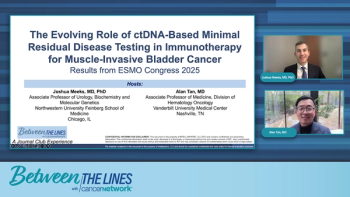
Optimal Dosing of Talquetamab
Panelists discuss how to operationalize talquetamab dosing in community settings by addressing the main challenges of infection risk and skin toxicity through patient education, proactive monitoring protocols, and careful patient selection, with early community experience showing manageable toxicity rates and the importance of setting proper expectations about skin and nail changes as markers of drug activity rather than concerning adverse effects.
Episodes in this series

Optimal Dosing of Talquetamab
Implementing bispecific antibodies in community practice faces significant challenges despite their proven efficacy. Despite widespread demand, only 10 facilities administer these therapies. The primary obstacles include managing infections and unique toxicities that extend beyond the initial treatment period, particularly the characteristic skin and nail toxicities associated with GPRC5D-targeted therapy like talquetamab. A community-based program has been developed to address these operational challenges, treating 130 patients with only a 3% discontinuation rate, demonstrating that successful implementation is achievable with proper infrastructure and patient education.
Patient education plays a crucial role in managing expectations and improving tolerability. The skin and nail toxicities, although concerning to patients, serve as biomarkers of treatment engagement and potential efficacy. These toxicities typically manifest within the first week of treatment and can persist for extended periods, requiring ongoing monitoring and supportive care measures. Early intervention with dermatological assessment and proactive management of skin-related adverse events helps maintain patients on therapy and prevents unnecessary treatment interruptions.
The community implementation model focuses on careful patient selection and comprehensive support systems. Not all patients are appropriate candidates for community-based bispecific therapy, with approximately 10% of referred patients being deemed unsuitable for treatment in this setting. Selection criteria emphasize patients who can reliably access care and comply with monitoring requirements. The success of this model suggests that with appropriate patient selection, robust supportive care protocols, and comprehensive patient education, bispecific antibodies can be safely and effectively administered in community oncology practices, potentially expanding access to these transformative therapies for a broader patient population who might otherwise face barriers to treatment at academic medical centers.
Newsletter
Stay up to date on recent advances in the multidisciplinary approach to cancer.
















































































